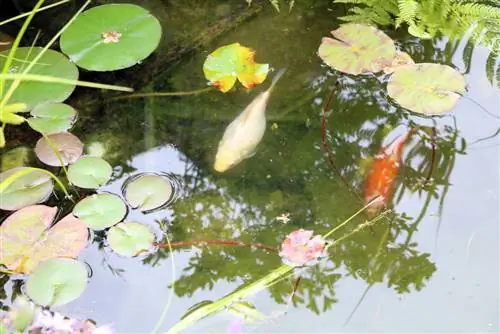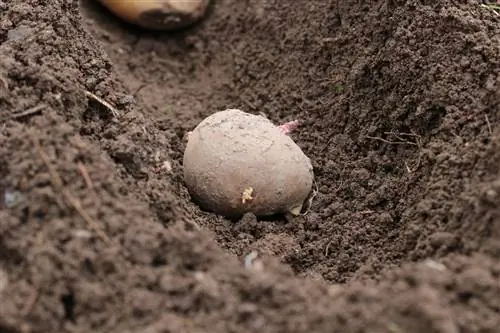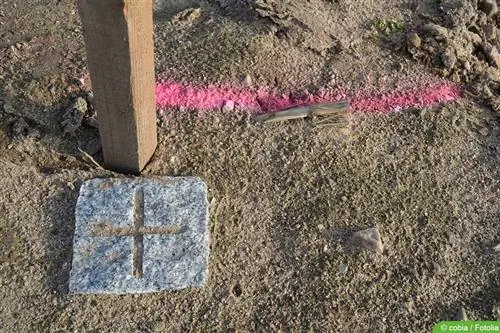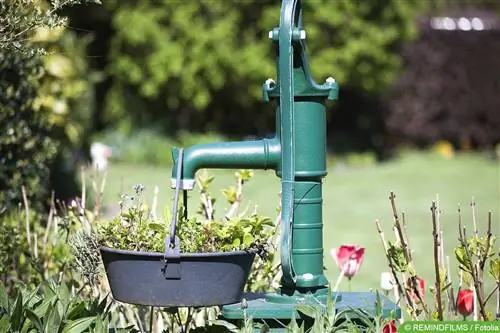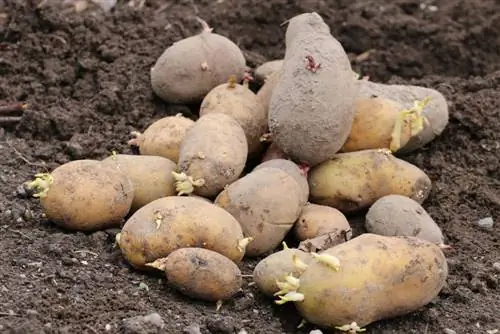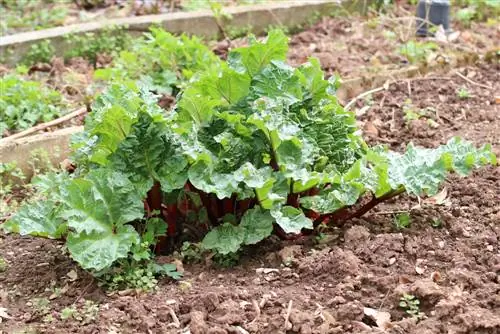- Author admin [email protected].
- Public 2023-12-17 03:39.
- Last modified 2025-06-01 06:48.
A garden pond can enrich the garden for people and animals. However, if goldfish are to be kept in it, it must be of the appropriate size and depth. This is especially true if the fish are supposed to overwinter in it. Because the right dimensions are important for the he alth and safety of the fish stock.
Volume
When it comes to the volume of the garden pond, the bigger the better. And in several ways. A more stable biological balance can be established in a large garden pond. Contamination such as falling leaves, leftover food, fish droppings or dead plant parts are therefore less of a problem than in a small pond. In addition, large garden ponds also have other advantages to offer:
Fish stock
Goldfish should at least be kept in small groups and will reproduce if the pond is well maintained. If this is the case, sooner or later the fish population in a small pond will have to be reduced. With a large volume this is needed much less frequently.
Predators
Cats but also herons, foxes and other animals see a garden pond with goldfish as a potential food source. A large volume gives the fish more opportunities to escape these predators.
Design
A bank area, different planting levels, parts of the garden pond in the shade and others illuminated by the sun - a large area with appropriate depth also goes hand in hand with extensive design options. Several and different plants can be introduced, which in turn serve as food sources and hiding places for the fish. The optics also benefit from it.
Cleaning
Because the balance in the water is more stable with a large volume, the garden pond needs to be completely cleaned less often and freed from accumulating sludge. However, an appropriate filter is still an important prerequisite. As well as the regular removal of accumulated dirt.
Wintering
Small ponds with shallow depths can freeze over despite appropriate precautions. In this case, the goldfish must be caught in the fall and wintered indoors. With a garden pond with a large volume, not only is the effort required for wintering less, it is also safer for the fish.
Size
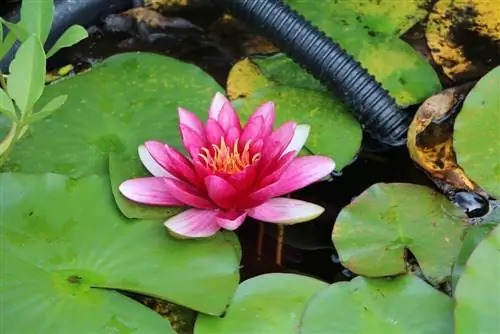
There is a simple rule of thumb when choosing the size of a garden pond for goldfish: At least three liters of water should be planned for every centimeter of goldfish's length. For five goldfish, each ten centimeters long, that would be:
- 5 fish x 10 centimeters per fish=50 centimeters fish length
- 50 x 3 liters=150 liters
What is not taken into account is the growth of the fish or their final size, possible reproduction and the volume of water that is allocated to plants. The following factors should therefore be taken into account when calculating:
- the first 1,000 liters should be used for aquatic plants
- Goldfish can reach a length of 35 centimeters depending on the type of breeding
- Goldfish spawn contains 500 to 3000 eggs
As a rule, only a small fraction of the eggs manage to be fertilized and hatch, but the rate of offspring can still be quite high. The size of the garden pond should therefore never only be calculated for the fish currently present. It is better to plan for the final size of the fish as well as a reserve for plants and offspring. Other aquatic creatures such as frogs, tadpoles and newts should also be included. Because they also release feces and use up the oxygen contained in the water.
The rough calculation could look like this:
- 5 fish x 35 centimeters length=175 centimeters fish length
- 175 x 3 liters per centimeter=525 liters
525 liters for the current fish population
+ 1,000 liters for aquatic plants
+ 1,000 liters for any offspring and other aquatic creatures
=2,525 liters
That sounds like a very large pond and the reserves are already generously calculated. In fact, with a round pond shape, a diameter and a depth of 1.5 meters each would be enough to achieve this water volume. The advantage of this generous calculation and the planned reserves is that the balance of the water is more stable and thus the cleaning effort is reduced - but safety is increased.
Depth
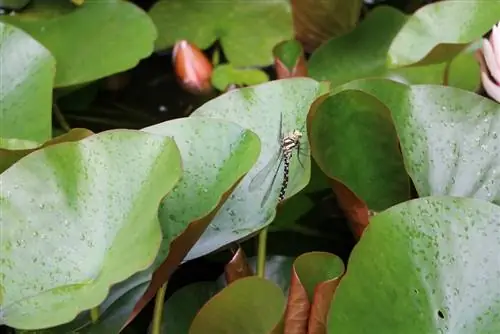
In addition to the circumference, radius or diameter, the depth of course also plays a decisive role in the size of the pond. On the one hand, it affects the water volume. On the other hand, greater depth offers better retreat options for the goldfish and thus protection from enemies. It also makes it easier for the fish to overwinter. The absolute minimum depth for goldfish is 80 centimeters. In summer there are still cooler water areas at depth. In winter, the garden pond cannot freeze completely. However, a depth of 1.0 to 1.5 meters is better. For a garden pond, a depth created in this way means:
- no complete freezing even in cold winters
- more stable temperatures throughout the year
- Cleaning and vacuuming pond sludge is still easy
- greater safety of the fish from predators, such as cats or herons
- Design of different sections and introduction of different plants possible
When creating a garden pond, a greater depth also means more effort. In the long term, however, there is an advantage primarily due to the safer and easier wintering of the goldfish. In addition, the fish can escape in summer when the upper water areas become too warm.
Calculate garden pond volume
The bigger, the better - that much is now clear. But how can you actually calculate the water volume in a garden pond? Because unless it is a perfect cuboid shape and the pond may also have sections of different shapes, the calculation seems difficult or even impossible. However, the solution to this is very simple. It is not the entire garden pond that is calculated, but rather the respective sections.
The areas of the respective shapes are first calculated and then multiplied by the depth of the section.
Squares and rectangles
For the area of rectangles and squares, only the side lengths are multiplied together.
Example:
Side length a x side length b=area (A)
1 meter x 2 meters=2 square meters
To calculate the volume, the depth is multiplied by the area.
A x Depth=Volume
2 square meters x 1.5 meters=3 cubic meters
Circles
For the area of a circular shape, the radius or half the diameter is first squared and then multiplied by the number Pi.
Radius² x Pi=Area (A)
(0.75 m x 0.75 m) x 3.14159=1.76715 square meters
For the volume of the round section, the area is multiplied by the volume.
Area (A) x Depth=Volume (V)
1, 76715 square meters x 1.5 meters=2, 65072 cubic meters
Ellipses or ovals
Elliptical or oval shapes are often chosen for garden ponds. The area is calculated by multiplying half of the axes with each other and by the number Pi. To calculate the semi-axes, the two side lengths are simply halved.
For a pond that is two meters long and one meter wide, the long semi-axis (a) is one meter, the short semi-axis (b) is 0.5 meters.
a x b x Pi=area
1 meter x 0.5 meters x 3.14159=1.5708 square meters
For the volume, multiply this result by the depth of the section as with the other shapes.
Area (A) x Depth=Volume (V)
1, 5708 square meters x 1.5 meters=2, 3562 cubic meters
Finally, the cubic meters only have to be converted into liters. One cubic meter is equal to 1,000 liters. A volume of three cubic meters holds 3,000 liters.

Tip:
However, it should be noted that these are only approximate values, as the pond usually tapers downwards - i.e. narrower. If you want to be sure that there is enough water for the desired number of fish, you should make the side lengths slightly larger and the target volume slightly higher.
Pond size and wintering
Garden ponds that are as large and deep as possible offer protection during overwintering and allow the goldfish to remain outdoors even during the cold season. But there's more to it, because it's not just the low temperatures that affect the fish.
The garden pond is usually designed so that it tapers towards the bottom. This also reduces the water volume at depth. If the pond freezes over from above, the goldfish not only have less space and water available, but also less oxygen. This is not a problem in itself, because the slowed metabolism during the winter also slows the fish's breathing.
But if the number of fish is large, the pond continues to freeze over or aquatic plants that are also in the pond consume oxygen instead of producing it, this condition becomes dangerous. In fact, most fish don't freeze to death in ponds; instead, they suffocate. In order to reduce this risk, the garden pond should be prevented from completely freezing over - regardless of how large and deep it is. The following measure is recommended for this:
- For small garden ponds, use a thick Styrofoam plate or, better yet, a special ice preventer. For larger ponds, there should be several Styrofoam plates or an ice preventer with an air pump.
- If a Styrofoam plate is used, a hole should be cut in the middle and a piece of garden hose inserted through it. The hose should be so long that it almost reaches the ground but is not stuck in the substrate.
- Weighing may be necessary to prevent the Styrofoam from floating too easily on the water and thus lying above the ice. For this purpose, heavier, larger stones are ideal, which are lightly pressed into the Styrofoam all around or glued to it. However, special weights can also be used.
Tip:
Styrofoam or ice preventers should be applied to the pond in autumn to provide protection in the event of early night frost.

